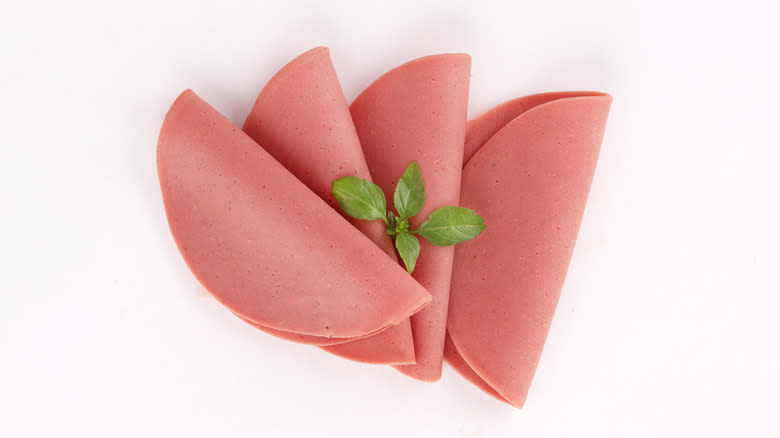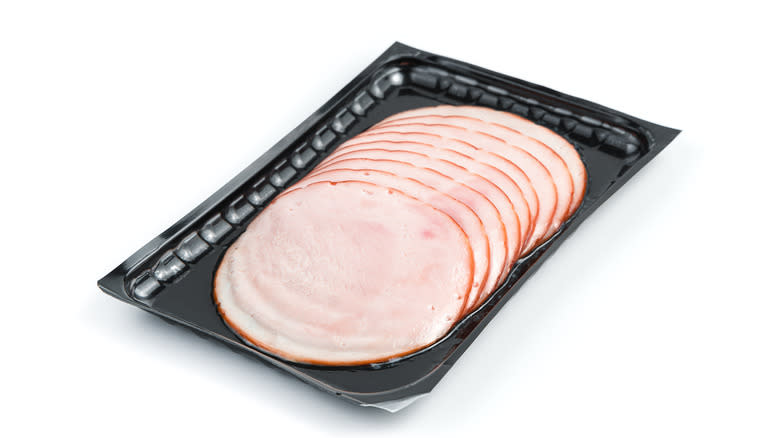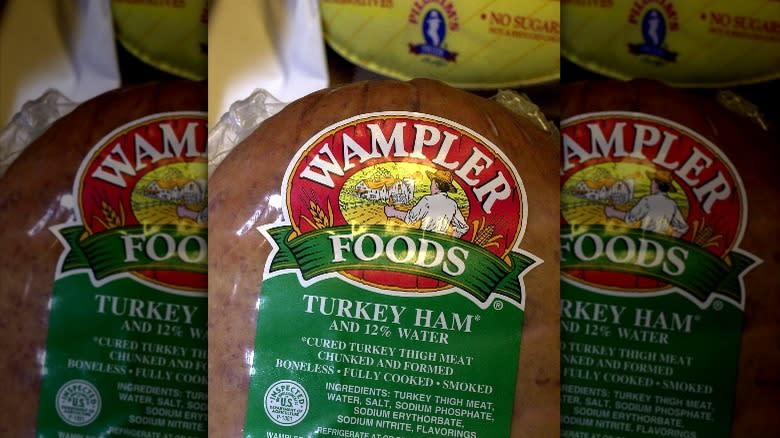What Is Turkey Ham And What Does It Taste Like?

You may have noticed turkey ham sitting in the deli aisle of your grocery store and thought to yourself: What in the world is that? At first glance, it makes about as much sense as a product labeled "chicken beef" or "salmon pork" — and besides, ham is legally required to be made with the thigh meat of a pig. But rest assured, turkey ham is made from turkey. There's no pork in it.
It's a similar type of confusion as the kind associated with almond milk and other non-dairy milk alternatives. According to a 1976 New York Times report, turkey ham caused legal troubles with pork producers similar to the ones non-dairy milks have had with dairy companies today. Obviously, turkey ham was able to keep its name, or we wouldn't know it as such today. But turkey ham products are now required to include a subheading of "cured turkey thigh meat" as a result of those legal troubles — just to clarify exactly what it is.
Read more: 8 Absolute Best Cuts Of Meat To Deep Fry
What Is Turkey Ham?

Turkey ham was invented by the national brand of turkey products Jennie-O in 1975 in collaboration with the influential agricultural scientist Robert C. Baker (whom the New York Times dubbed "chicken Edison" in 1984). It's a cured and sometimes smoked meat made from the upper leg of turkeys — aka turkey thighs. You'll find it sold either as deli slices or as a whole piece of meat, similar to how traditional ham is sold. Turkey ham is a processed food, fully cooked and ready to be eaten right out of the package.
Turkey ham is marketed as a healthy alternative to regular ham, with an emphasis on the difference between red and white meat. But although turkey ham can have a darker tinge to it relative to other white meat products, it still isn't considered red meat. Red meat is defined as any meat coming from mammals, while white meat includes poultry. Since turkey is poultry and not a mammal, turkey products will always be white meat regardless of what color they are after they've been processed.
How Is Turkey Ham Made?

Since turkey ham is made to imitate the flavor and texture of regular ham, it's prepared in a similar way. Ham can be prepared in many different ways, but the bird's eye view of the process of making boneless ham is that it's cured, smoked, or both.
For turkey ham, the turkey thigh meat is first deboned. It's then cured by injecting a mixture of salt, sugar, sodium diacetate, sodium erythorbate, sodium phosphate, sodium nitrite, potassium lactate, and water into the meat. Curing meat is a process of food preservation that dates back to 3,000 B.C. There are both wet and dry curing methods; dry curing meat involves rubbing a mixture of salt and seasonings on the outside of the meat, while wet curing, though similar, adds water to make a brine. Turkey ham uses a wet method, as does traditional ham. The turkey is submerged in the brine and left to rest for several hours; afterward, the meat is cooked, completing the cure.
What Does Turkey Ham Taste Like?

Turkey ham tastes, well, like ham. It has a similar salty brininess to it that we so often associate with deli meat ham. There's also a touch of sweetness, but it isn't honey-sweet by any means. The texture is somewhat chewy without being rubbery — if you're familiar with the texture of most processed deli meats, turkey ham is consistent with the other styles.
The outside of turkey ham is often layered with smoked paprika, which gives it another leg up in flavor. It doesn't have any heat to it, but the paprika does contribute a decent degree of spice to an otherwise tame flavor profile. Of course, deli meat does tend to have a predominantly salty flavor profile, and that's the case with turkey ham as well, despite the addition of the smoked paprika. And while you probably wouldn't want to add it to a sweeter dish, the turkey ham will generally pair well with other foods since it won't overpower anything else.
How To Cook With Turkey Ham

When purchased as deli slices, turkey ham is most often used in sandwiches. Grab some bread, some of your favorite toppings, and some mayonnaise — and there you go. But just because the classic use of turkey ham is a sandwich doesn't mean you can't get creative. Turkey ham can be incorporated into mashed potatoes, pasta salads, and omelets, too.
Of course, you can also try substituting turkey ham whenever you are making a recipe that calls for traditional ham. You may be familiar with the slight taste and texture differences between bacon and turkey bacon, and while the difference here isn't quite as extreme, there are similarities to how ham and turkey ham compare. They can otherwise be used fairly interchangeably. Turkey ham and traditional ham have similar textures, and since turkey ham is made with the same process as regular ham, they have similar flavors — so you likely won't even need to adjust your recipe if you're trying to swap one meat for the other.
Where To Buy Turkey Ham

Since turkey ham isn't as popular as other deli meats, you may have some difficulty finding it. But even though it often takes a backseat to other meat options, it's still widely available. (You may want to check your grocery store's website to see if they have it before making a special trip to buy some, though.) If you are looking for a whole turkey ham instead of deli meat slices, go to the butcher counter and ask them if they have any available.
You'll often see turkey hams from bigger brands like Jennie-O and Butterball, which make their products available all over the United States and online. Still, smaller brands with a more artisanal take on turkey ham are available if you want something a little nicer. Of course, the bump in quality comes with a bump in price. Check your local butcher shops to see if they carry turkey ham, or order from an online meat retailer if your usual grocery store isn't an option.
Nutritional Information About Turkey Ham

Each brand of turkey ham will have some variation in nutrition since they each may have slightly different processing methods. A 2-ounce slice of turkey ham is a typical serving size for most brands, though. With that comes a solid 7 to 10 grams of protein, making turkey ham a solid addition to your diet if you're looking to increase your protein intake. You'll also get a bump of potassium — anywhere from 2% to 4% of the daily recommended value. The turkey ham will also net you some iron, similarly around 2% to 4% of your daily recommendation.
On the downside, turkey ham is very high in sodium. Curing meat takes a lot of salt, and that shows, with a typical turkey ham serving boasting a whopping 300 to 500 milligrams of sodium. Put it this way: If you eat only five 2-ounce slices of turkey ham, you will have already met or exceeded your daily recommended sodium intake. It'll also have 25 to 30 milligrams of cholesterol and around 2 to 3 grams of fat.
Of course, as processed meat, turkey ham isn't going to be a particularly health-conscious option unless you're specifically looking for protein. That said, turkey is a lean meat, and in moderation alongside other foods, it can be a tasty part of a nutritionally balanced diet. Just remember that deli meats can carry an increased risk of listeria, so pregnant people may want to avoid it (via the American Pregnancy Association).
Read the original article on Tasting Table.

